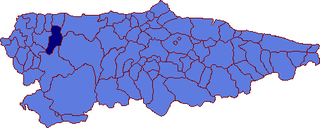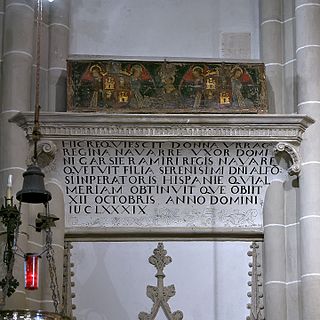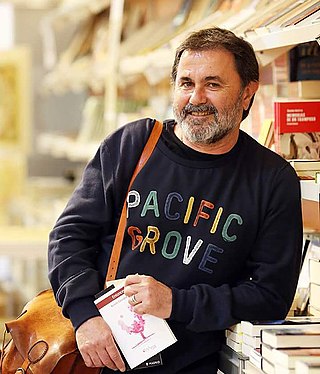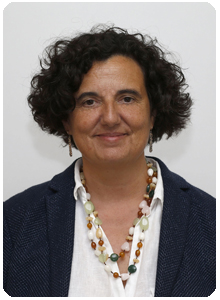
Asturleonese is a Romance language spoken primarily in northwestern Spain, namely in the historical regions and Spain's modern-day autonomous communities of Asturias, northwestern Castile and León and Cantabria, and also in a small neighbouring area of Portugal. The name of the language is largely uncommon among its native speakers, as it forms a dialect continuum of mutually intelligible varieties and therefore it is primarily referred to by various regional glossonyms like Leonese, Cantabrian, Asturian or Mirandese. Extremaduran is sometimes included as well. Asturleonese has been classified by UNESCO as an endangered language, as Asturian is being increasingly replaced by Spanish.

Boal is a municipality, a civil parish and a town in the Autonomous Community of the Principality of Asturias (Spain). It borders north with El Franco and Coaña, south with Illano, west with Castropol and east with Villayón.

Avilés is a town in Asturias, Spain. Avilés is, along with Oviedo and Gijón, one of the main cities in the Principality of Asturias.

The Vaqueiros de Alzada are a northern Spanish nomadic people in the mountains of Asturias and León, who traditionally practice transhumance, i.e. moving seasonally with cattle.

The Academia de la Llingua Asturiana or Academy of the Asturian Language (ALLA) is an Official Institution of the Government of the Principality of Asturias that promotes and regulates the Asturian language, a language of the Spanish autonomous community of Asturias. Among its principal objectives are investigating and normalising the Asturian Language, developing a dictionary, promoting its use and education and awarding literary prizes. It has 21 full members, 19 foreign members and 15 honorary members, and its current president is Ana María Cano González.

Asturian is a West Iberian Romance language spoken in the Principality of Asturias, Spain. Asturian is part of a wider linguistic group, the Asturleonese languages. The number of speakers is estimated at 100,000 (native) and 450,000. The dialects of the Astur-Leonese language family are traditionally classified in three groups: Western, Central, and Eastern. For historical and demographic reasons, the standard is based on Central Asturian. Asturian has a distinct grammar, dictionary, and orthography. It is regulated by the Academy of the Asturian Language. Although it is not an official language of Spain it is protected under the Statute of Autonomy of Asturias and is an elective language in schools. For much of its history, the language has been ignored or "subjected to repeated challenges to its status as a language variety" due to its lack of official status.

Villayón is a municipality in the Autonomous Community of the Principality of Asturias, Spain. It is bordered on the north by Navia, on the west by Coaña, Boal and Illano, on the east by Valdés, Tineo y Allande and on the south by Allande.

Galician–Asturian or Eonavian is a set of Romance dialects or falas whose linguistic dominion extends into the zone of Asturias between the Eo River and Navia River. The dialects have been variously classified as the northeastern varieties of Galician, as a linguistic group of its own, or as a dialect of transition between Galician opinion upheld by the former president of the Academy of the Asturian Language (ALLA) José Luis García Arias

Asturians are a Romance ethnic group native to the autonomous community of Asturias, in the North-West of the Iberian Peninsula.

Lugones is a parish in Siero, a municipality within the province and autonomous community of Asturias, in northern Spain.
The Berdín Palace is located in the village of Doiras, in Boal, Asturias, Spain.

Saint Peter of Nora is a Roman Catholic Pre-Romanesque church, located in Las Regueras, Asturias, Spain, beside the Nora river, about 12 km from Oviedo. The church is recorded for the first time in a donation document of Alfonso III of Asturias in 905.

Urraca Alfonso, also known as Urraca the Asturian, illegitimate daughter of Alfonso VII of León, was Queen Consort of Navarre by her marriage to García Ramírez. After becoming a widow, she returned to her homeland and was the regent of Asturias from 1153 to 1165. Urraca was involved in a rebellion against her half-brother, King Ferdinand II of León and with her second husband, Álvaro Rodríguez de Castro attempted to secure the independence of Asturias.

Aurelio González Ovies is a Spanish writer and poet from Asturias. He has a Ph.D in Classical Philology and he is a Professor of Latin Philology at the University of Oviedo. In words of the writer Victor Alperi:

The Sociedad Económica de los Amigos del País de la Habana or Real Sociedad Patriótica de la Habana is a learned society in Havana, Cuba. It was initially organized to promote agriculture, commerce, education, and industry, modelled on the Sociedad Económica de los Amigos del País in Spain. Founding members included Diego de la Barrera, Francisco Joseph Basabe, José Agustín Caballero, Luis de Las Casas, Juan Manuel O'Farrill, Tomás Romay y Luis Peñalver, and Antonio Robledo. In its early decades the group produced publications, maintained a library in the Convento de Santo Domingo (1800-1844), and arranged educational programs. Around the 1790s the group built the Hospicio o Casa de Beneficencia in Havana.

A braña is a seasonal pasture in the Cantabrian Mountains of northwest Spain, particularly in Asturias, Cantabria, and northern León. Brañas support several types of transhumance and can be used during different periods of the year, though the word is most often associated with summer usage.
Diamantina Rodríguez was a Spanish singer. She was named as one of the most important Asturian singers of the twentieth century. She began her career in 1948 in a contest, where she placed second. She recorded her first album in 1969, and died in 2021 aged 100.
Florina Alías was a Spanish author, a member of the Xeneración de la posguerra.

Berta Piñán Suárez is an Asturian writer, professor of Spanish Language and Literature, full member of the Academy of the Asturian Language, and since July 25, 2019, Minister of Consejería de Cultura, Política Lingüística y Turismo del Principado de Asturias.















